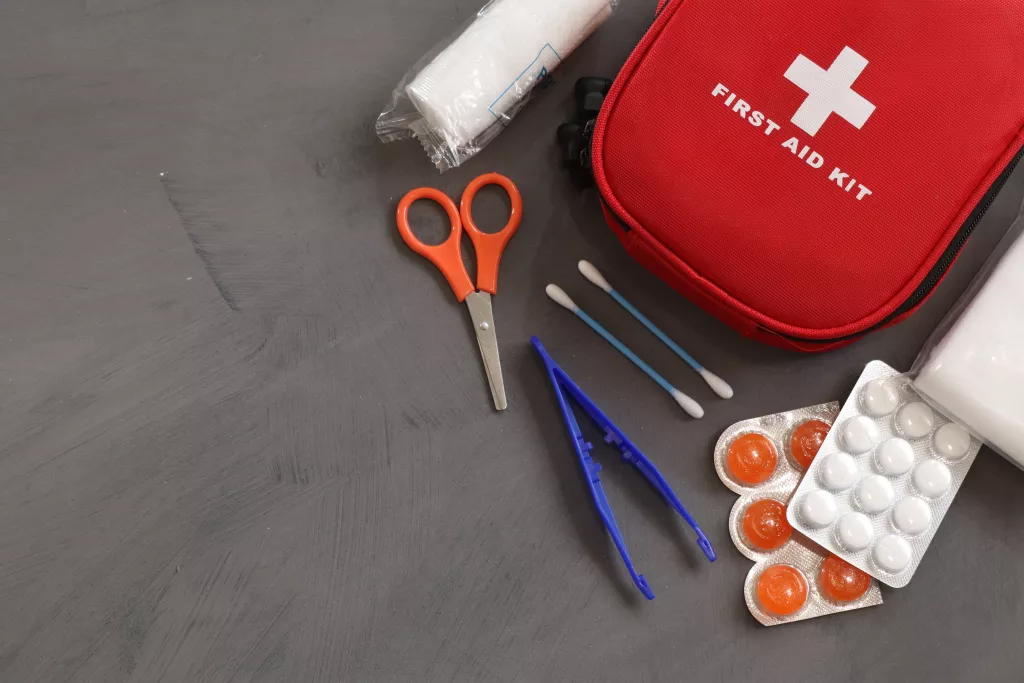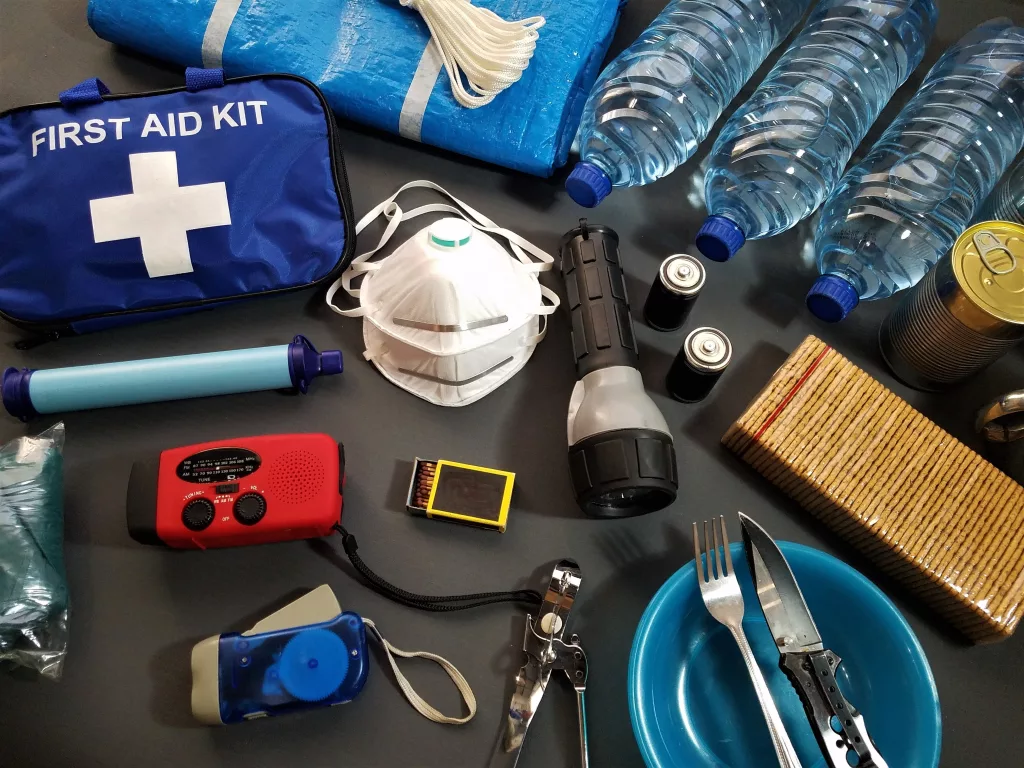Even a small hurt can seem scary when it’s unplanned. That’s where the small survival first aid kit comes in, a silent helper with tools to steady, calm down and maybe even save the day. Making your own kit, though, can be like going through a medical labyrinth. Fear not, intrepid adventurer! This guide will help you learn everything you need about making the best first aid kit. It’s made just for what you need, and can take on any health problems that happen in life.
The Vital Role of Survival First Aid Kits:
Imagine this: You’re far from people on a camp trip when your friend gets a bad cut after falling down a rocky path. Getting scared could make you think wrong, but if you have a good first aid kit, you can change into someone who helps quickly. These simple kits are special because they connect harm and professional care. They give important help during the crucial one-hour after an injury, maybe stopping problems and helping things get better.

Understanding the Importance of Emergency Preparedness:
Emergencies come without warning by their nature. If it’s a sudden storm, sickness or accidental mistake then being ready can help a lot. A good first aid kit is important for being ready. It lets you take care of small injuries and sickness by yourself with confidence until a doctor comes. Imagine it like something that can help you when things are tough and give you more time until someone comes to assist.
Overview of What a Well-Equipped First Aid Kit Entails:
An important small box for first aid should have all the basics you need to be ready medically. This typically includes:
• Wound care: Different types of bandages, gauze pads, sticky tape for skin, clean cloth soaked in medicine and strips to close wounds.
• Pain relief: Pain medicine from the store like ibuprofen or acetaminophen.
• Allergy relief: Antihistamines for allergic reactions.
• Burn care: Burn cream and sterile dressings.
• Splinting materials: Band-aids shaped like triangles, sticky and bands to use for help.
• Personal protective equipment (PPE): Gloves, masks, and eye protection.
• Emergency essentials: Emergency blanket, flashlight, and whistle.
Remember, this is just the start. What you need in your kit will be different based on where you usually go and what things you need.

Assessing Your Needs: Building a Kit That’s Uniquely You
Now that we’ve talked about how survival kits are important and the need to be ready, it is time for each of us to make our own medical tools. Keep in mind, what works for one person may not be perfect for another when it comes to first aid. Just like making the best travel plan, creating a first aid kit needs you to think about what you really need and your special situation.
Tailoring Your Kit to Your Lifestyle:
• The Adventurer: If you love adventure and enjoy being outside, your things should be good for possible hiking problems, bug bites and sunburns. Add strong bandages, bug spray, sun protection and even pluckers for taking out ticks.
• The Homebody: Even people who don’t like to go out can gain from having a good kit ready. Imagine slices from cooking mistakes, small burns, and relief for seasonal issues. Buy band-aids, burn cream, allergy medicine and a device to check your temperature.
• The Globetrotter: Traveling the world lets you see special places and can lead to health problems. Bring the medicine you need, plus a big antibiotic and some things to purify water and DEET bug spray. Remember, this is only the beginning. Make your kit fit with the things you like, activities you do and places where often go.
Considering Specific Health Conditions or Allergies:
If you or someone important to you have long-term health problems or allergies, your kit should take care of those needs. For example, people with diabetes need to bring blood sugar test things and insulin. Those who are allergic must bring their emergency antihistamines or epinephrine auto-injectors.
Factoring in the Number of Potential Users:
Your kit should be big enough and have things for the number of people it may help. A family kit will usually be bigger and have more stuff than one for a single hiker. Make sure you have all the supplies to fully take care of everyone who could need your emergency kit.
Now that you have figured out what you need, let’s talk about the essential things. They should be in every survival first aid kit to make it complete.
Must-Have Basics:
Bandages and Dressings:
These are the main items in any first aid box. They help cover wounds, keep them safe from germs and aid healing. Very important for this task! Stock up on a variety of sizes and types, including:
• Adhesive bandages: For different sizes and types of scratches, cuts or blisters.
• Sterile gauze pads: To absorb blood and fix larger wounds.
• Conforming bandages: Flexible and stretchy for difficult-to-get spots like bones.
• Triangular bandages: Slings, dressings for injured spots and helping to create splints.
Antiseptics and Disinfectants:
It’s really important to prevent germs when looking after cuts or bruises. Pack:
• Alcohol wipes: Simple to use for cleaning small cuts and scrapes.
• Antiseptic solution: Like iodine or povidone-iodine, these can be used to clean large wounds.
• Hydrocortisone cream: Helps with itchiness and lessens swelling from bug bites or little allergy reactions.
Medical Tools: Scissors, Tweezers, Thermometer:
These handy tools allow you to handle specific tasks with precision:
• Scissors: Choose the ones with flat tips to safely and cleanly cut bandages and gauze.
• Tweezers: Useful for removing splinters, ticks and other things that don’t belong.
• Thermometer: The digital thermometer is quick and easy to use for checking body temperature. It’s very important when you feel hot like having a fever or being sick.
Medications and Pain Relief: Soothe the Ache, Ease the Worry
Having the right medicines and pain relief in your first aid kit doesn’t replace doctor care, but it can greatly help manage small hurts and illnesses. Let’s go through this important part of your stuff with sureness.
Prescription Medications:
If you need daily medicine from a doctor, it’s very important to bring enough with you for your activity or trip. Remember, don’t skimp! Bring more stuff just in case there are surprises or things we didn’t expect. Make sure drugs have clear labels and keep them in sealed boxes to protect from water and changes in heat.
Over-the-Counter Pain Relievers:
Let’s face it, pain happens.Make sure you have medicine to take every day like ibuprofen, acetaminophen or naproxen. This will help with headaches and sore muscles and fever. Remember to have some medicine for problems like stomach pains or feeling sick, and also use allergy medicines to stop allergies from being bothersome.
Including Allergies and Specific Conditions:
If you or someone in your group has allergies or ongoing health issues, make sure to adjust your kit for those needs. For allergies, take emergency antihistamines or epinephrine auto-injectors if the doctor says so. For problems like diabetes or asthma, make sure you have enough things to handle episodes or troubles. This could be blood sugar testing kits for diabetes and inhalers for asthma.
Crafting a Comprehensive Wound Care Section:
A little scratch or tiny cut, wound care is a key part of every first aid kit. Let’s make sure you have the proper tools to deal with those expected knocks and scrapes without fear.
Sterile Gauze and Dressings:
These are the unknown heroes of wound care. Buy different sizes of clean gauze pads to soak up blood, cover cuts and put pressure on them. Add sterile gauze rolls for big cuts or burns that are clean.
Adhesive Bandages for Various Sizes:
From small cuts on the fingertips to bigger scrapes, it’s important to have different sizes and shapes of sticky band-aids. Pick waterproof bandages for activities that include water or wetness.
Wound Closure Strips and Butterfly Bandages:
For straight cuts with clear edges, these special bandages help shut the wound fast and speed up healing. They’re a good choice instead of stitches for little cuts, and they can be very useful for face injuries.
Conclusion: Your Personal Guardian Against Life’s Little Emergencies
Congratulations! You’ve made your special survival health kit, showing how much you care about getting ready and staying healthy. Remember, this isn’t something that doesn’t change; it grows with your needs and experiences. Check and change your kit often, taking out old things that have passed their date and adding new stuff based on what you’re doing or if it affects your health.
FAQs:
How frequently have to I replace my first aid kit?
Ideally, evaluation your kit each 6 months and replace expired items right away. Before any prolonged trip or activity, provide it a thorough take a look at to make certain the whole lot is present and practical.
What ought to I do if I stumble upon a major injury or medical emergency?
Your first aid package is supposed for minor conditions. In case of a severe injury or scientific emergency, are searching for expert medical attention immediately. Call emergency services and utilize primary life assist skills if you realize them.
Are there any on-line resources for constructing a primary useful resource package?
Yes! Several legit organizations provide useful guidance and checklists for constructing first useful resource kits. The American Red Cross, CDC, and Wilderness Medical Associates are proper starting factors.
Can I examine simple first aid abilities?
Absolutely! Taking a primary first useful resource or CPR path can equip you with crucial information and competencies to handle emergencies with self assurance. Many groups provide those publications, and on-line assets are also to be had.
